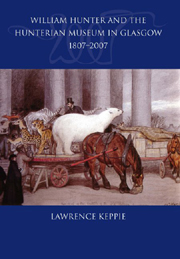Book contents
- Frontmatter
- Contents
- Foreword by Sir Kenneth Calman
- Introduction
- List of Illustrations
- Acknowledgements
- Abbreviations used in the Notes
- Dedication
- 1 William Hunter's Life and Career
- 2 Growth of the Hunterian Collection
- 3 ‘The Noblest Legacy upon Record’
- 4 A Temple of the Muses: the First Hunterian Museum in Glasgow
- 5 ‘This Place of Fascination’: the Impact of the Museum, 1807–70
- 6 A New Museum for a New University, 1870–1900
- 7 The Twentieth Century: War, Peace and Renewal, 1900–75
- 8 The Hunterian Art Gallery
- 9 Modern Times, 1975–2007
- 10 Overview: Meeting William Hunter's Intentions
- Postscript: Looking to the Future
- Notes
- Appendix: Catalogues of the Hunterian Collections
- Bibliography
- Index
- Plate section
5 - ‘This Place of Fascination’: the Impact of the Museum, 1807–70
Published online by Cambridge University Press: 12 September 2012
- Frontmatter
- Contents
- Foreword by Sir Kenneth Calman
- Introduction
- List of Illustrations
- Acknowledgements
- Abbreviations used in the Notes
- Dedication
- 1 William Hunter's Life and Career
- 2 Growth of the Hunterian Collection
- 3 ‘The Noblest Legacy upon Record’
- 4 A Temple of the Muses: the First Hunterian Museum in Glasgow
- 5 ‘This Place of Fascination’: the Impact of the Museum, 1807–70
- 6 A New Museum for a New University, 1870–1900
- 7 The Twentieth Century: War, Peace and Renewal, 1900–75
- 8 The Hunterian Art Gallery
- 9 Modern Times, 1975–2007
- 10 Overview: Meeting William Hunter's Intentions
- Postscript: Looking to the Future
- Notes
- Appendix: Catalogues of the Hunterian Collections
- Bibliography
- Index
- Plate section
Summary
Early visitors and their expériences
On 26 August 1808 ‘Thomas Hutchison, merchant, Edinburgh’, signed his name in ‘the Strangers Book’. He is the first known member of the public to have been admitted when the collections became accessible on a regular basis. The Museum became, almost immediately, a highly popular attraction both for the people of Glasgow and visitors to the city. Frequently visitors called at the College as part of a much wider tour, often encompassing the romantic Scottish Highlands. Their accounts offer an invaluable response to the collections. There was frequent objection to the need for an admission fee (see p. 75).
The Trustees' Minutes record under June 1810 that ‘the numbers who daily visit, out of mere curiosity, are so great, as to divert too great a portion of the Keeper's time from the other important duties of his office.’ Between August 1808 and June 1810 some 10,000 visitors signed the Album in the Anteroom. These visitor registers are in themselves a valuable index of social history, handwriting, spelling and travel habits. On 15 September 1809, Dr Matthew Hunter Baillie and a party of eleven, including members of his family, were in the Museum, but he has left us no account of his reactions at seeing the collection housed in the building which had for so long occupied his thoughts.
- Type
- Chapter
- Information
- Publisher: Edinburgh University PressPrint publication year: 2007

